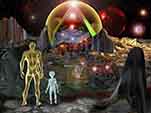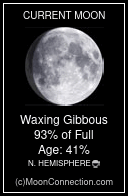The Winnemucca Institute for Advanced Studies presents
Why is the Night Sky Dark
In the past it was argued, in an infinite and eternal universe no matter where you look in the night sky you should see a star. Stars should stand shoulder-to-shoulder as well as overlap each other in the night sky, like tree trunks as seen from the middle of a very thick forest. When we look up, there should be a star in every pinprick of the sky. Because of this, the sky at night should be very bright indeed, and should be glowing, or even ablaze with light. So why isn't it ? This was a subject of debate for hundreds of years. Many noted philosophers and scientists have weighed in on this paradox. In the historical record it can be traced to Thomas Digges in the mid 1500's, Johannes Kepler in 1610, Edmond Halley in the 1700's, German astronomer Heinrich Wilhelm Olbers in 1823, Edgar Allen Poe in his prose poem essay "Eureka" in 1848, Lord Kelvin in 1901, Carl Charlier in 1908, Benoit Mandelbrot in 1974 and John L. Dobson in 1979. It was popularized as a paradox when Olbers wrote about it in 1823 and it subsequently became known as Olbers' Paradox; which is the argument that the observed darkness of our night sky is in seeming contradiction with the apparent fact of an infinite and eternal Steady State Universe, or even a finite and short lived Universe as some religions postulate.
Olbers' Paradox is; that if the Universe, for all practicable purposes, is infinite and static, then at any given angle from the Earth your line of sight will end at the surface of a star. In addition, in a near infinitely old Universe there's been plenty of time for the light from every star that has ever shone to reach our eyes, and so the night sky should be ablaze with starlight. In attempts to explain this Paradox 19th century scientists thought dust clouds between the stars must be absorbing the starlight. Later scientists argued that the dust itself would absorb so much energy from the starlight that it too should be glowing.
The first ones to set out a currently accepted somewhat satisfactory resolution of the Paradox were Lord Kelvin in a revised version of a Paper later added to his 1884 "Baltimore Lectures" that was published in "Philosophical Magazine" in 1901, and Edgar Allan Poe's prose poem essay "Eureka" published in 1848, in which Poe interestingly anticipated several qualitative aspects of Kelvin's later more scientific arguments [1]. Poe writes;
"Were the succession of stars endless, then the background of the sky would present to us an uniform luminosity, like that displayed by the Galaxy – since there could be absolutely no point, in all that background, at which would not exist a star. The only mode, therefore, in which, under such a state of affairs, we could comprehend the voids which our telescopes find in innumerable directions, would be by supposing the distance of the invisible background so immense that no ray from it has yet been able to reach us at all." Poe then immediately negates the argument he just stated in saying, "That this may be so, who shall venture to deny ? I maintain, simply, that we have not even the shadow of a reason for believing that it is so." Poe was in favor of a 'finite' Universe, not an 'infinite' Universe. Kelvin also took the position of a finite Universe, but used the argument Poe so well stated and then decried, and put it into a mathematical formulation, one which the math community so very loves and accepts as true.
In other words, Poe suggested in the negative argument; the infinite size of the Universe should show a star at every point in our sky, but because light has a finite speed, and infinity is so big, light has not yet been able to reach us from the majority of the most very distant background stars. Interestingly, by the 1830's several experiments measuring the speed of light had pegged it to being 167,000 miles/second, almost 90% of our current measurements, and Poe mentions this fact. However, as both Poe and Kelvin preferred a finite size to their Universe, they had to figure the size of the universe we could see, as opposed to the size of the Universe itself, in making their calculated determination of why the sky is dark. This argument of 'the size of the Universe that we can see' was a new insight.
In a defense of Poe, Poe also writes, but in a different section of his "Eureka"; "Have we, or have we not, an analogical right to the inference that this perceptible Universe - that this cluster of clusters - is but one of a series of clusters of clusters, the rest of which are invisible through distance - through the diffusion of their light being so excessive, ere it reaches us, as not to produce upon our retinas a light-impression - or from there being no such emanation as light at all, in these unspeakably distant worlds - or, lastly, from the mere interval being so vast, that the electric tidings of their presence in Space, have not yet - through the lapsing myriads of years - been enabled to traverse that interval ?" Poe, through the course of his various sessions in writing "Eureka", experiences different perspectives of belief, due to his relentless pursuit of Truth, and perhaps to following where his own logic has led him. His logic has led him to the doorstep of understanding that our galaxy, or 'nebula' as it was called in those days, was but one of many 'clusters', and that there were "clusters of clusters" which were "invisible through distance". Poe was standing on the threshold of understanding the galaxy structure of the Universe, and did so long before anyone had observed other galaxies !
From what was known about stars, space, and the Universe, up until the twentieth century, it seemed very reasonable that the Universe was infinitely old, infinitely large, and basically unchanging in its totality, and in such a Universe Olbers' Paradox was a real problem. In the religious world of humans it was also a big problem, in that the Universe should still be large enough, despite its youthful age, to show a star in every pinprick of the sky. In the nineteenth and early twentieth century the 'galaxy structures' of the Universe were not as yet understood by astronomy. Indeed, astronomers didn't even know there were other galaxies besides our own until the 1930's, and then astronomers suddenly realized the Universe has multitudes of galaxies ! Previously, it was considered that space was simply filled with stars which were dispersed somewhat uniformly, if not randomly, throughout space. It was not understood that galaxies are like islands, and groups of islands, and separated by enormously vast distances from each other, with the giant voids between them unpopulated by any stars whatsoever, and this recently discovered fact leads to an enormous lessening of stellar light flux density when one now considers the total volume of space that we observe. This 'island galaxy' and "clusters of clusters" structure of the Universe is a major contributor to why the night sky is dark ! These dark and enormous empty voids between the glowing starlit galaxies hugely reduces the overall total amount of starlight being generated in the Universe. For if all those dark gigantic voids between the island galaxies were filled with glowing stars, our night sky would indeed be ablaze with light !
Another, more modern, partial answer to the Paradox is Redshift. The Redshift of distant galaxies; the lengthening of the wavelength of light due to the absorption and re-radiation by interstellar dust and possibly intergalactic dust, would move starlight out of the visible light range and into the infrared range, a range which is not visible to our eyes.
The Paradox resolution proposed by Carl Charlier in 1908, and later rediscovered by Benoit Mandelbrot in 1974, postulates that if the stars in the Universe are distributed in a hierarchical 'fractal' cosmology, the average density of any region diminishes, as the region considered increases in size. This would demand an increasingly darkening sky at every increasing distance.
John L. Dobson in his 1979 self-published pamphlet "Advaita Vedanta and Modern Science" explains how "Partly the night sky is dark because the red shift of the radiation from the distant galaxies which we can see robs that radiation of some of its energy. But mostly the night sky is dark because the red shift of the radiation from beyond about 15 billion light years away would rob that radiation of all of its energy so that we could see nothing at all." The 15 billion light year distance is subject to revision of course, but it is Dobson's astute observation that the redshift over distance creates a 'boundary' beyond which we cannot receive information, because at a far enough distance the red shift will completely reduce our 'data received' to 'zero', and a 'subjective border' to our 'observational universe' will manifest itself. Dobson continues, "Actually, it is the red shift itself, rather than our interpretation of the red shift, which imposes this boundary, and it is an observational boundary, not an actual boundary. It is not a boundary which could be visited. The observer is always at the same distance from it, in all directions." This 'observational boundary' of our 'awareable universe' is one of Dobson's great contributions to the night sky dark paradox solution, and his using red shift to substantiate it, is its modern aspect.
Our observable portion of the Universe is a finite part of the Universe at large; therefore we cannot see all of the stars, only the finite number of stars in our observable portion of the Universe. The density of stars within this finite volume of our Observable Universe is sufficiently low that any line-of-sight from Earth is more likely to NOT see a star, than it is TO see a star. And so, regardless of whether the Universe itself has a finite or infinite age, or a finite or infinite size, there would only be a finite number of stars in any angular direction within our finitely 'observable portion' of space.
A painstaking 15 year project by researchers at the University of Nottingham to reassess images from NASA's Hubble Space Telescope has found that the number of stars in our Observable Universe is actually far greater than previously thought. Decades have been spent in trying to answer the question of how many galaxies are contained in our Observable Universe. Observations since the early 1990's led astronomers to believe the number was around 100 Billion, but new census counts suggest their estimates were far too low. In fact, there are at least twenty times more galaxies in the night sky, some two Trillion, suggesting there are easily enough stars to make the night sky bright. In addition, they used new mathematical models, which allowed them to infer the existence of galaxies that our current generation of telescopes cannot yet observe, and which lie within our theoretically observable portion of the Universe. Astronomers have concluded that because these newly considered galaxies are so far away, their starlight is completely absorbed by intergalactic dust and gas. This led to the surprising conclusion that in order for the number of galaxies we now see and their masses to add up, there must be a further 90-percent of galaxies in our theoretically Observable Universe that are too faint and too far away to be seen with present-day telescopes. The authors also suggest that distant and red-shifted galaxies could have their light absorbed by gas and dust in the void of space, then re-emitted in the infrared and lower wavelengths, wavelengths that are invisible to our human eyes.
In our own galaxy, some of the light emitted by all those stars is absorbed by interstellar dust. In fact, we cannot directly observe the center of our own galaxy (nor the 'opposite half') in visible light at all, we only see it in the lower and higher frequencies, the radio and x-ray spectrum wavelengths. If it weren't for all the intervening dust in the central region of the Milky Way, and in the spiral arms between us and the central region, our galaxy would be much brighter in the visible light wavelengths in the night sky, and it might be as bright in totality as a waxing gibbous Moon !
Questioning why the night sky is dark instead of ablaze with light can lead to incredibly interesting possible conclusions regarding the nature of the Universe. So the next time you're in awe of the beauty of the stars, consider the profound implications of the darkness too !
In the end; Olbers was correct, as were Digges, Kepler, Halley, Poe, Kelvin, Charlier, Mandelbrot and Dobson. They puzzled over the logical reasoning that the night sky should be as bright as the midday Sun, and in fact it is ! What they didn't realize is that the night sky is only dark to us. If they, and we, had eyes sensitive to radio, microwave, infrared, ultraviolet, x-ray and gamma ray wavelengths, they would never have seen a Paradox, they would have seen the light !
[1] All in regards to Poe - Did Kelvin read "Eureka" ? I would venture to say he did ! And I also suspect that a great many others did as well !! , as "Eureka" has quite a long history of being published and republished by half a dozen well known publishers of their day, and well into the 20th, and now the 21st century. Poe also explores in "Eureka" several other of his ideas, ideas that were then further developed in the 20th century and have yielded such concepts as; the Big Bang Theory, Black Holes, and the Pulsating Theory of the Universe (although this is Hindu Philosophy and goes way back before Christ and Roman times), and perhaps the most important of all, the idea that our Milky Way Galaxy is only one of a near endless succession of "island nebulas", all autonomous in their nature and essence, and fading into the distance of their multitudes, which Edwin Hubble didn't confirm until the 1930's.
Poe also likened the structure of the atom to be similar to the structure of our solar system, and to the structure of the Universe. "Let us now, expanding our conceptions, look upon each of these systems as in itself an atom; which in fact it is, when we consider it as but one of the countless myriads of systems which constitute the Universe. Regarding all, then, as but colossal atoms, each with the same ineradicable tendency to Unity which characterizes the actual atoms of which it consists - we enter at once upon a new order of aggregations."
In regards to Poe's logic that the Universe is inhabited by a succession of "island nebulas" stretching into the vast distances of unknowability, he writes; "The Galaxy, let me repeat, is but one of the clusters which I have been describing - but one of the mis-called "nebulae" revealed to us - by the telescope alone, sometimes - as faint hazy spots in various quarters of the sky. We have no reason to suppose the Milky Way really more extensive than the least of these "nebulae"."
Poe continues: "We comprehend then, the insulation of our Universe. We perceive the isolation of that - of all that which we grasp with the senses. We know that there exists one cluster of clusters - a collection around which, on all sides, extend the immeasurable wildernesses of a Space to all human perception untenanted. But because upon the confines of this Universe of Stars we are compelled to pause, through want of farther evidence from the senses, is it right to conclude that, in fact, there is no material point beyond that which we have thus been permitted to attain ? Have we, or have we not, an analogical right to the inference that this perceptible Universe - that this cluster of clusters - is but one of a series of clusters of clusters, the rest of which are invisible through distance - through the diffusion of their light being so excessive, ere it reaches us, as not to produce upon our retinas a light-impression - or from there being no such emanation as light at all, in these unspeakably distant worlds - or, lastly, from the mere interval being so vast, that the electric tidings of their presence in Space, have not yet - through the lapsing myriads of years - been enabled to traverse that interval ? Have we any right to inferences - have we any ground whatever for visions such as these ? If we have a right to them in any degree, we have a right to their infinite extension."
"That the Universe might endure throughout an era at all commensurate with the grandeur of its component material portions and with the high majesty of its spiritual purposes, it was necessary that the original atomic diffusion be made to so inconceivable an extent as to be only not infinite. It was required, in a word, that the stars should be gathered into visibility from invisible nebulosity - proceed from nebulosity to consolidation - and so grow grey in giving birth and death to unspeakably numerous and complex variations of vitalic development: - it was required that the stars should do all this - should have time thoroughly to accomplish all these Divine purposes - during the period in which all things were effecting their return into Unity with a velocity accumulating in the inverse proportion of the squares of the distances at which lay the inevitable End."
Poe considered "Eureka" his most important work, to be regarded as being above all of his other writings, and for what he should be most remembered !! Like Buckminster Fuller, he sure had a big vocabulary. "Eureka" is really most amazing !
Information provided herein by the Winnemucca Institute for Advanced Studies is for educational purposes. Our ‘Man on the Street Series’ of informative Science Papers is designed to provide a semi-technical answer to everyday experiences.






































